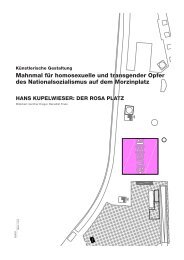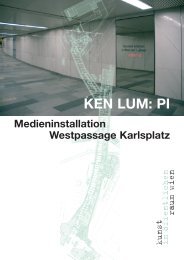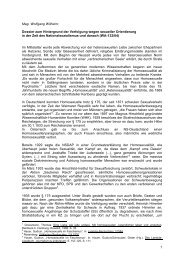KEN LUM: PI
KEN LUM: PI
KEN LUM: PI
You also want an ePaper? Increase the reach of your titles
YUMPU automatically turns print PDFs into web optimized ePapers that Google loves.
Language and its Reference to<br />
the World in Ken Lum’s Work<br />
Ken Lum, born in 1956 in Vancouver (Canada) as the son of<br />
Chinese immigrants, has been working since the 1980s mainly<br />
in photography and text. In billboard series, he studies the<br />
design potential of advertisement. The growing interest in the<br />
artistic potential of photography in the past one and a half<br />
decades has contributed to Lum’s greater international recognition.<br />
Next to Jeff Wall, he has meanwhile become one of the<br />
best known Canadian artists.<br />
Wall has praised Ken Lum’s work in numerous essays, stressing<br />
its references to art history. “Lum makes references to the<br />
journalistic aspects of Dada, Surrealism and Constructivism,<br />
and tries to introduce the experimental idioms of global<br />
modernism in the everyday language of cities.”<br />
To quote Wall again:<br />
“With the compositions of his signs Lum imitates the countless<br />
distorted, vaporized visual spaces of the 20th century, thus<br />
partaking of abstract painting, working in a playful way with<br />
their logos and turning them in a cheerful recapitulation of<br />
constructivist, lettristic and conceptualist demands to the everyday<br />
life of the urban world.”<br />
This art historical development which could in different terms<br />
be described as international Modernism is based on a<br />
global idiom which Ken Lum reflects on in his “Language<br />
Paintings” and his later billboard series. Ken Lum, for instance,<br />
works first of all with differently shaped and turned letters.<br />
While his “Language Paintings” are still variations on spatial<br />
concepts of painting – from simple and flat compositions to<br />
allusive spaces that resemble Kandinsky in some respects –,<br />
the artistic works of the later billboards refer to the public<br />
languages of advertising and design. The method of reflection<br />
is a recombination of textual and pictorial pieces asserting<br />
a familiarity with the structures and codes of discursive<br />
public media but also formulating collective culture in a new<br />
way.<br />
In the billboard series “There is no place like home”, portraits<br />
of persons from the entire social spectrum are combined with<br />
highly personal and emotional texts that can be read as statements<br />
made by these persons. In the portrait-billboard series<br />
“Schnitzel Company” where, similar to company advertising,<br />
the so-called “employee of the month” is presented, a suggestive<br />
reality effect is produced. Just naming the names<br />
and the given months elicits a curiosity for more detailed bio-<br />
<strong>KEN</strong> <strong>LUM</strong>: <strong>PI</strong><br />
Ken Lum, There is no place like home, 2001<br />
Billboard project in public space, Innsbruck<br />
graphic details that are expected in the multi-ethnic backgrounds<br />
of these employees of a fictive fast-food chain. The<br />
globalized world of labor with its sweeping integrative potential<br />
raises the question of identity even more dramatically with<br />
the serial nature of the pictures and their slight difference.<br />
In recent years, Ken Lum has also turned to the fleeting<br />
mirror portrait. At the Documenta11 2002 he combined highformat<br />
mirrors with small portrait photographs that were<br />
casually stuck in the frames. The use of mirrors together with<br />
text in the Westpassage Karlsplatz in Vienna marks a further<br />
development in Lum’s works which revolved around identity<br />
and language from the very outset. In his media installation Pi,<br />
Lum deals with the subject of statistics, referring to the world<br />
with his numeric details. 14 reflective panels, on to which inscriptions<br />
have been etched, have been mounted on the side<br />
walls of the passage. Below these dryly formulated statements<br />
a LED display has been mounted. The numbers visualized<br />
change on the basis of statistic data collected by mean of<br />
social scientific methods and on the basis of mathematical<br />
prognosis models and related algorithms. Ken Lum refers to<br />
an example from which he derived his idea: “In New York there<br />
is a large countup clock that depicts the public state debt in<br />
the USA. The numbers keep jumping upward every single<br />
second.”<br />
In the underground pedestrian passageway below the Karlsplatz<br />
in Vienna, the pedestrians are reflected in the individual panels.<br />
While they read the current numeric values on the digital<br />
counter, they – the readers – merge with the number in a performative<br />
sense.<br />
kunst<br />
im öffentlichen<br />
raum wien<br />
5





